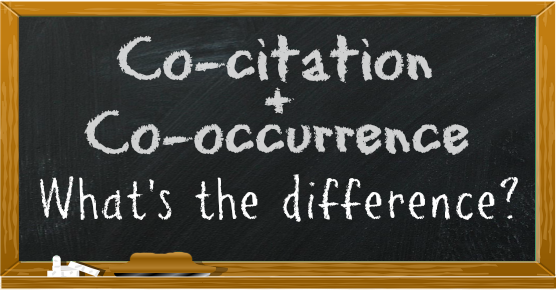Who Cares about Co-Occurrence and Co-Citation?
The science of search engine optimization contains many arcane concepts. Furthermore, as Google continues to alter its algorithm, the list of concepts grows longer. In this post, we will discuss two concepts with similar names but with very distinct functions: Co-Occurrence and Co-Citation. Using these two concepts in your SEO efforts is very easy, but have big pay-offs.
What is Co-Occurrence?

Google’s algorithm now takes note of which keywords commonly appear together in sentences. This phenomenon is known as Co-Occurrence
The concept of Co-Occurrence began as just a theory of SEO pioneer Rand Fishkin. In 2012, Fishkin noticed that there were web pages regularly ranking in the top three without ever having the keyword they ranked for within their content. As he described the situation in his own words:
“For the query “cell phone ratings,” coming in at number four is a web page on ConsumerReports.com without the words “cell phone” or the word “ratings.” Actually, I do think they have the word “rating,” and they might have the word “phone.” But it’s in the text. It’s not even in the title. Really remarkable that they’re ranking so well for such a competitive query.
Number two, “manufacturing directory.” Again, another very competitive phrase, and ThomasNet is ranking number three without mentioning any of these terms, without seeming to try and target that phrase at all.
Number three, “backlink analysis,” where Open Site Explorer, SEOmoz’s own tool ranks number two, and yet not in the title. It’s not anywhere on the page. Neither of these words are anywhere on the page. In the snippet, Google is actually using some text from another article that they found that mentions backlink analysis.”
With this in mind, consider the above image. The underlined text on the left represents the text which co-occurs with the underlined text on the right, which would represent a brand or any other search term. To further demonstrate how this works we will go through more examples.
Co-Occurrence Examples
If on several pages across the internet there are mentions of “Snapple” and “the best tea beverage on the market” within their content, then an organic search for “what is the best tea beverage on the market?” would hypothetically result in Snapple ranking high.
Similarly, if several bloggers are writing content talking about how the “Golden State Warriors” are the “best team in history” in the “NBA”, an organic search of “what is the best NBA team in history?” would result with Golden State’s page ranking high.
How to Use Co-Occurrence
The best way to use Co-Occurrence in your SEO strategy is to just write great content which people will want to talk about and share. Great content shared amongst friends on social media will create the natural Co-Occurrence which will help boost your page past what your coding could do on its own. For this reason, it is important to do a regular co-occurrence analysis on the internet to see what subjects are commonly being paired together, that you might be part of this trend.
What is Co-Citation?

The concept of Co-Citation is that the various sites linked to a certain page must have some relation to one-another.
Co-citation is another advanced SEO concept which uses others’ content to boost your page’s ranking. It is well known that page-links play a large role in a website’s Google ranking, but the concept of Co-Citation delves deeper into the subject.
The reasoning behind Co-Citation is that good websites will link to other good websites, creating a veritable “good neighborhood“, just as bad websites will link to other bad websites creating its own “bad neighborhood“. Thus a web-designer must take care when linking to other sites, or seeking inbound links, as associating with a “neighborhood” of bad websites will reflect poorly on one’s ranking. Furthermore, the reasoning behind Co-Citation is that linking to high-quality sites provides for a better user experience.
Co-Citation Examples
If you are a plumbing supply company and you link to spammy, poorly-optimized plumbing blogs (assuming such things exist), Google can only assume that your website is of a similar repute.
Similarly, if you are a sewing blog that links to poorly-optimized sewing-supplies eCommerce stores, you are also culpable, and Google cannot rank you higher.
How to Use Co-Citation
In practice, you can incorporate the concept of Co-Citation by researching webistes before deciding to link to them or to seek links from them. If your potential partners do not provide good user experiences, Google will recognize this, and penalize your site if you decide to link to them. (Hint: Check to see if a page optimizes its images. This is a quick audit of a site’s seriousness.)

